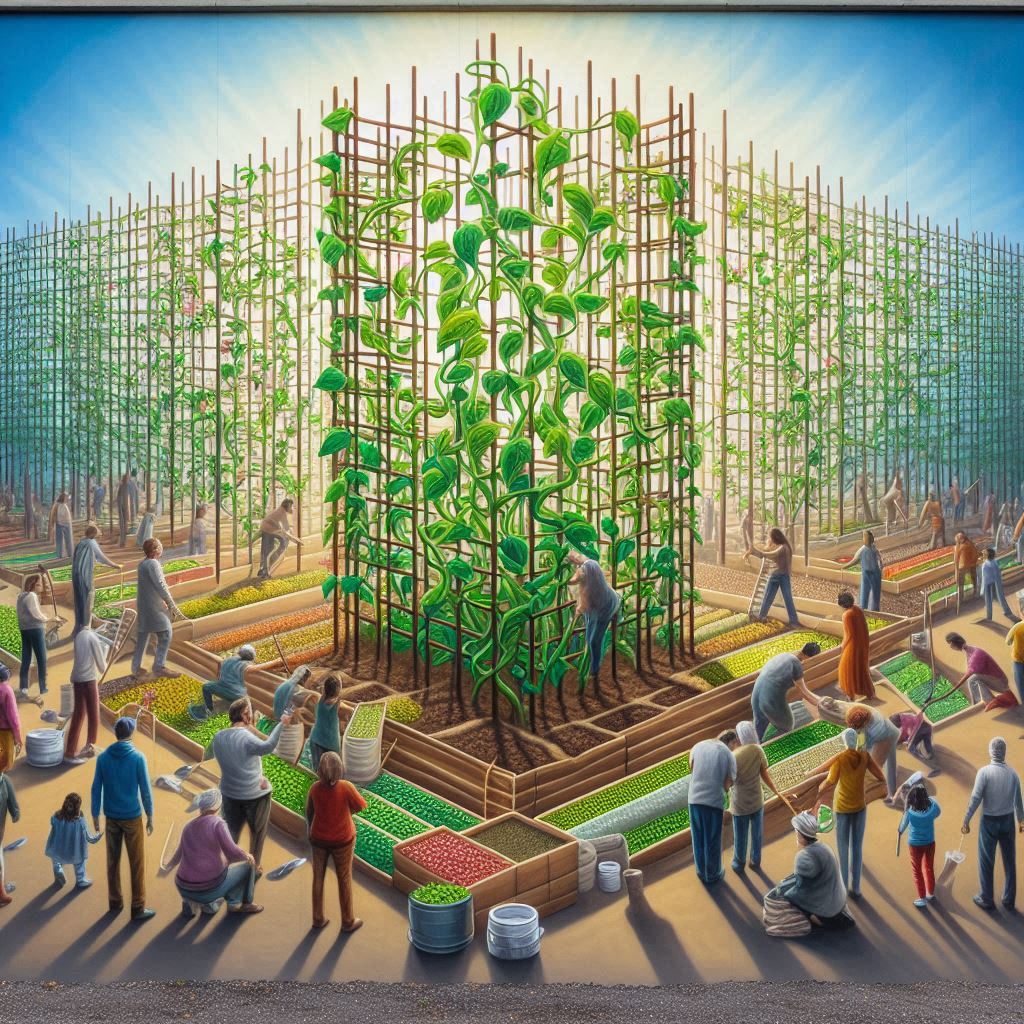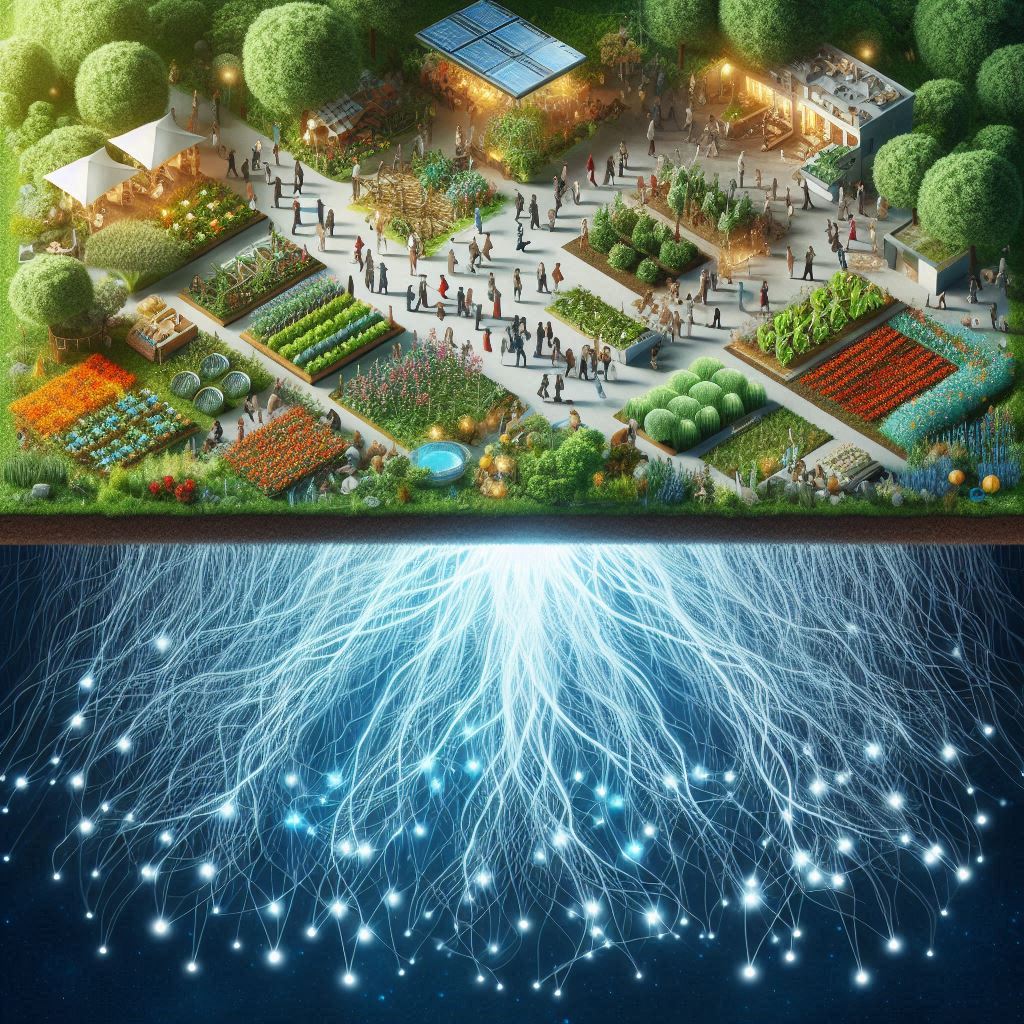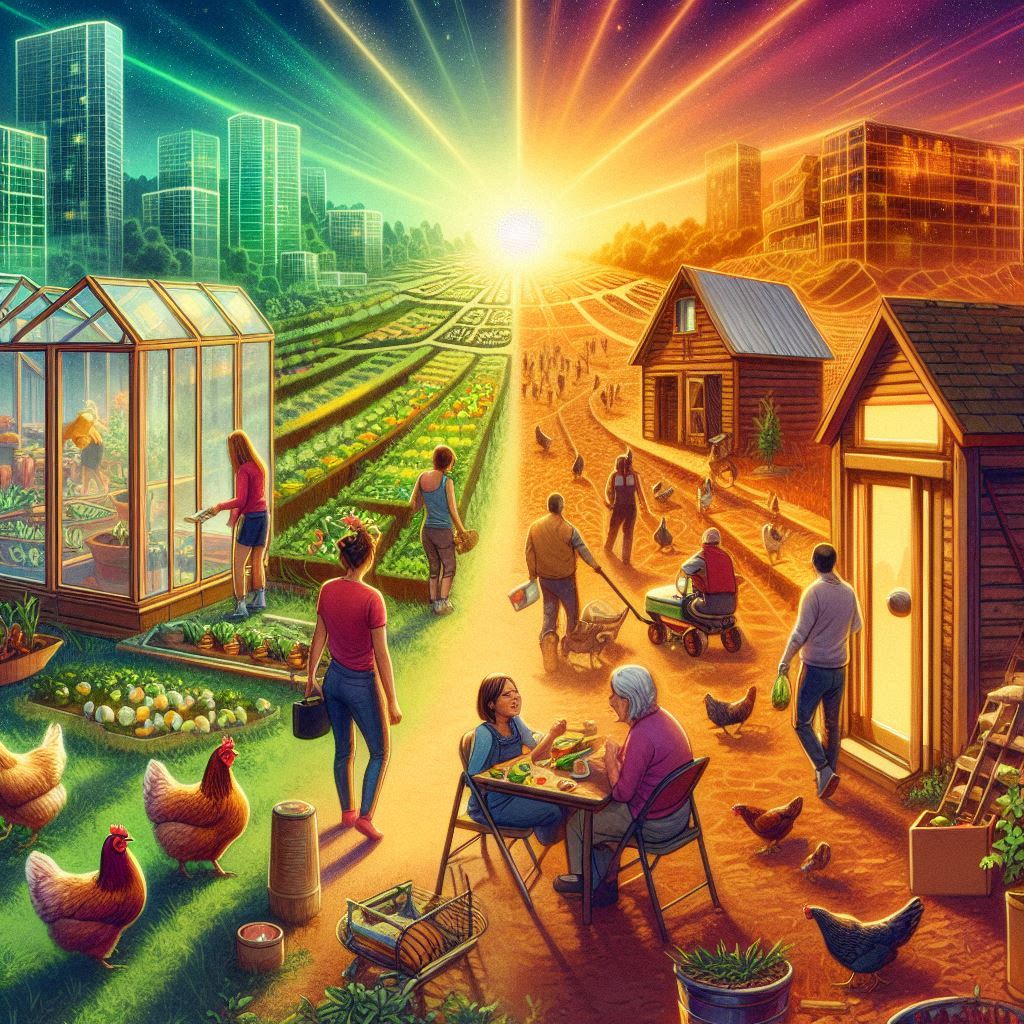Beneath the forest floor, invisible to the casual observer, lies the true architect of ecosystem health: vast networks of mycelium connecting trees, cycling nutrients, and enabling life to flourish. What if our approach to rebuilding trust in American institutions followed a similar pattern? This is the story of a possibility waiting to unfold…
The Spark of Recognition
Two weeks ago, something shifted in my understanding of what’s possible.
I stood in a crowded breakout session at the General Forum on Ethereum Localism (GFEL) in Boulder, watching Will Ruddick—who’d traveled all the way from Kenya—explain how his Grassroots Economics organization is revitalizing struggling communities not through charity, but through connection.
“When people say there’s no money in a community,” Will explained, his eyes alight with conviction, “what they really mean is that there’s no medium to connect abundant local resources with genuine local needs.”
He showed images of thriving marketplaces in communities that conventional economics had written off as “too poor.” The secret wasn’t injecting external resources—it was creating systems that revealed and activated what was already there.
As I listened, years of frustration with disconnected systems suddenly resolved into clarity. The problem I’d been wrestling with wasn’t unique to food systems—it was universal. And the solution wasn’t more control, but better connection.
The Patterns We Can’t See
For years, I’ve watched the same patterns play out across communities:
- Food banks overflowing with processed foods while local produce rots in fields
- Churches with commercial kitchens used once monthly while nearby neighbors lack cooking space
- Eager volunteers with time but no coordination systems
- Abundant resources and genuine needs existing side by side, yet never connecting
We keep trying to solve these problems through more programs, more funding, more control. But what if these approaches are actually preventing the natural connections that would solve these problems organically?
The American paradox surrounds us: unprecedented abundance alongside widespread struggle. This isn’t a resource problem—it’s a connection problem.
From the wealthiest CEO to the poorest street dweller, we’re all experiencing disconnection. Our society, built along mechanistic lines, has inadvertently dammed the natural flows that sustain healthy communities. Like the ancient Canaanites sacrificing to Moloch while their society crumbled, we keep repeating patterns that harm the common good because “that’s how it’s always been done.”
What might future generations look back and wonder: what the hell were we thinking?
From Theory to Practice: The Weekend Challenge
This coming weekend, after our solstice celebration concludes, I’m testing a simple hypothesis: What happens when we create the conditions for connection rather than trying to control the outcome?
I’ve issued a challenge to our local and global regenerative design community, and even to fellow GFEL attendees: let’s build backyard cold frames together, starting with reclaimed doors as greenhouse lids. My partner Melissa has already found three more commercial doors we’re committing to this initial resource pool.
This isn’t just about extending the growing season. It’s about creating a substrate for something much larger to grow—a mycelial network of relationships, resources, and mutual support that can expand organically.
I can already envision what might emerge:
- Neighbors who’ve never spoken sharing seeds and gardening knowledge
- Retired tradespeople finding purpose teaching basic skills to younger families
- Local businesses setting aside materials that would otherwise be discarded
- The first threads of a community fabric being rewoven, not through programs, but through practice
One cold frame becomes five. Five become twenty. A pattern emerges, spreads, evolves.
The Trellis and the Bean: A Vision Growing Forward
As I look at the garden beds where these cold frames will soon extend our growing season, I see a powerful metaphor for what’s possible:

In a garden, a trellis doesn’t control how beans grow—it provides structure while allowing them to follow their natural patterns.
This single image transforms how we might understand institutional trust-building:
- Institutions provide structure (resources, frameworks, knowledge) without dictating direction
- Communities grow naturally according to their own wisdom and needs
- The result is more abundant growth than either could achieve alone
What might happen if we applied this approach at scale?
Beyond Cold Frames: The Network Expands
I can see a clear pathway from this humble beginning to something transformative:
From cold frames to chicken coops. From chicken coops to automated backyard gardens. From individual gardens to neighborhood food forests. From neighborhood initiatives to partnerships with community gardens, food banks, and farmers markets.
But the most powerful expansion isn’t in the projects themselves—it’s in who can participate.
Imagine:
- The homeless veteran who helps build cold frames today receiving support for stable housing tomorrow
- The single mother who receives community-grown food now contributing her time and skills when she’s back on her feet
- The isolated elder whose knowledge becomes a valued community resource
- The busy executive finding purpose through corporate volunteer programs aligned with community needs
Each contribution—whether materials, time, knowledge, or connections—becomes visible and valued in a system that recognizes all forms of wealth.
Mweria: Ancient Wisdom Meets Modern Tools
The brilliance of the Mweria systems Will Ruddick shared isn’t in their novelty, but in their ability to make visible what’s always been true: communities thrive when contribution is recognized and resources flow freely.
Blockchain technology isn’t creating something new—it’s amplifying something ancient: the human capacity to build trust through visible contribution to community wellbeing.
This technology allows us to verify not just financial transactions, but all forms of community contribution. Someone builds reputation by sharing garden produce, volunteering time, or teaching skills.
The implications are revolutionary: a system where trust isn’t manufactured through marketing but emerges naturally through verified action.
Corporate Connection: Healing the Whole
Perhaps most surprising is how this approach might heal another severed connection—between corporations and communities.
Corporate wellness and volunteer programs represent billions in potential resources, yet often struggle to create meaningful impact. Why? Because they’re designed as one-way giving rather than mutual exchange.
What if corporations could participate in these community networks not just as donors, but as true stakeholders?
Imagine:
- Corporate volunteer days that contribute to lasting community infrastructure
- Employee wellness programs aligned with community garden initiatives
- Business expertise flowing into community projects
- Community wisdom informing more sustainable business practices
The boundaries between “corporate” and “community” begin to dissolve, revealing what’s always been true—these aren’t separate entities but aspects of the same living system.
Institutional Evolution: From Control to Connection
As our nation grapples with declining trust in institutions from government to media, perhaps we’re asking the wrong questions. Instead of “How do we make people trust institutions again?” we might ask, “How do we create the conditions where trust emerges naturally?”
Initiatives like the Department of Government Efficiency aren’t addressing the real problem. It’s not about ferreting out fraud or slashing bureaucracy—it’s about reconnecting systems to the communities they’re meant to serve.
What if government agencies could participate in these community networks not as remote authorities but as responsive partners? What if healthcare institutions could tap into community wisdom about wellbeing? What if educational institutions could learn from natural knowledge-sharing patterns?
The future of institutional trust isn’t in better PR campaigns or more transparency initiatives—it’s in fundamentally reimagining the relationship between institutions and communities.

The Mycelial Future
The path I’m describing isn’t utopian—it’s biomimetic. It follows patterns that have sustained life for billions of years:
- Nutrients flow to where they’re needed
- Information travels through relationship networks
- Diverse elements collaborate rather than compete
- Waste becomes food for new growth
- Systems evolve through feedback rather than control
Like the mycelium beneath a forest floor, these trust networks can become the invisible but essential infrastructure that enables our communities and institutions to thrive together.
The work happens in the gaps between existing structures—just as mycelium travels through the cracks in pavement. It doesn’t replace current systems; it connects and enhances them.
This approach requires profound humility. It means recognizing that communities already possess the wisdom they need. It means understanding that institutions work best when they provide structure without control. It means trusting that abundance emerges naturally when we remove the barriers to connection.
An Invitation to Grow Together
This weekend’s cold frame project isn’t just about extending our growing season. It’s the first visible thread of a mycelial network that could transform how we understand community resilience and institutional trust.
The invitation is open:
- Start with what’s already moving in your community
- Create connections rather than solutions
- Provide structure without imposing control
- Make contribution visible through whatever tools you have
- Trust in natural growth patterns
This isn’t a technique—it’s a fundamentally different way of seeing and being in the world. It’s recognizing that trust isn’t something we build directly, but something that emerges when we create the right conditions.
In my garden, I don’t “make” beans grow. I create the conditions—soil, water, trellis—and trust in their natural capacity. Perhaps our institutions might learn from this ancient wisdom.
The journey from control to connection isn’t easy, but it may be the only path that leads us home—to communities where trust flows as naturally as nutrients through mycelial networks, nourishing us all.
This is how we grow trust—not by building it directly, but by creating the conditions where it emerges naturally from authentic relationship and demonstrated action.
Shannon Dobbs is the founder of Food System Hackers and a regenerative systems designer focused on rebuilding trust between communities and institutions. His work bridges traditional wisdom with modern technology to create resilient systems that honor both human and natural patterns.

